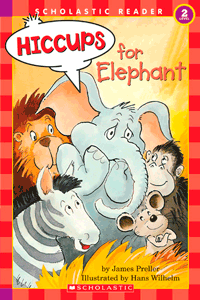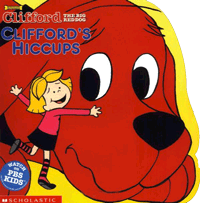Secure Checkout. FREE SHIPPING for Continental U.S. Orders over $60.
Menu
-
- Home
-
About Us
-
The Approach
-
Linking Language & Literacy
-
Professional Learning
-
Learning Resources
-
SHOP
-
Blog
-
- About MindWing
- Our People
- Contact Us
- Your Account
- Login
-
United States (USD $)

Secure Checkout. FREE SHIPPING for Continental U.S. Orders over $60.
Elephants Get the Hiccups?! Fun Lesson Teaching Kick-Offs and Compare/Contrast
by Sheila Zagula June 27, 2016 3 min read
Recently, I came across two books at my local library that both had the same Kick-Off: Hiccups for Elephant by James Preller and Clifford’s Hiccups adapted by Suzanne Weyn. In each, the main Character in the story has the hiccups. Maryellen Moreau has completed a workshop activity using the Preller book shown below.
 In the Hiccups for Elephant book, the hiccups that the elephant has is an Initiating Event (Kick-Off) for the animals in the forest who do not like being awakened by the hiccups, and each have a remedy to offer. The elephant, himself, is not seeking a remedy.
In the Hiccups for Elephant book, the hiccups that the elephant has is an Initiating Event (Kick-Off) for the animals in the forest who do not like being awakened by the hiccups, and each have a remedy to offer. The elephant, himself, is not seeking a remedy.
It was a ho-hum day: “It was naptime and the animals were fast asleep…”
UNTIL SUDDENLY…the elephant hiccupped.
This is the Kick-Off for each of the animals in their turn. The book is written as a series of Reactive Sequences: There is a Kick-Off SO there is a Reaction.
|
Example:
SO
|
Continue with each of the other animals. Below, we took each of the characters and added Feelings, a Plan, Direct Consequence and Resolution in order to make each one of the mini-reactive sequences into an episode with all the story grammar components. Note the bolded portions which would have to be inferred for Complete Episode.
|
|
NEW ![]() Kick-Off: Elephant sneezes!!!!! The children could come up with a reaction from each of the other animals to “cure” the sneeze. Pictures could be drawn.
Kick-Off: Elephant sneezes!!!!! The children could come up with a reaction from each of the other animals to “cure” the sneeze. Pictures could be drawn.
By giving examples at the Reactive Sequence and Complete Episode stages of narrative development, we have differentiated instruction. Furthermore, the actions of each animal could make up an Action Sequence mobile:
|
|

 By using the concept of the Braidy, the StoryBraid’s Developmental Sequence for differentiating instruction, as well as tiered intervention (more detailed), you can teach students at their levels with goals for the next level attainment.
By using the concept of the Braidy, the StoryBraid’s Developmental Sequence for differentiating instruction, as well as tiered intervention (more detailed), you can teach students at their levels with goals for the next level attainment.
Note how the same book could be used at different stages of narrative for instructional purposes, yet all children hear a read-aloud or read the same book.
 The Clifford selection is a similar story with the main character having the hiccups and others trying to help him get rid of them. Reading both of these short selections to the children and using Braidy/SGM to retell the stories would then lend itself to a wonderful activity for Compare/Contrast. Elicit responses from the children using the map as to how the two stories are same/different. This particular Compare/Contrast map for younger students can be downloaded below.
The Clifford selection is a similar story with the main character having the hiccups and others trying to help him get rid of them. Reading both of these short selections to the children and using Braidy/SGM to retell the stories would then lend itself to a wonderful activity for Compare/Contrast. Elicit responses from the children using the map as to how the two stories are same/different. This particular Compare/Contrast map for younger students can be downloaded below.

I also used our SGM Mini Magnets to talk about the completed map showing the correlation to the narrative retelling components.

Refer to our blogs of May 6, 2016 (Collaboration in the Classroom with Story Grammar Marker and Big Al) and November 20, 2015 (Part 3, Hilda Must Be Dancing and Giraffes Can’t Dance — Compare/Contrast) for further ideas!
Sheila Zagula
Sheila Zagula works with MindWing Concepts in product development, drawing on her expertise and talents as well as many years of implementing the Story Grammar Marker® and related materials. Her teaching career spans thirty-eight years, most recently as literacy coach in the Westfield Massachusetts Public School System. Sheila has experience as an early childhood educator, a teacher of children with special needs, and a collaborative instructor within an inclusion framework serving children in grades K-5.
Leave a comment.
Comments will be approved before showing up.
